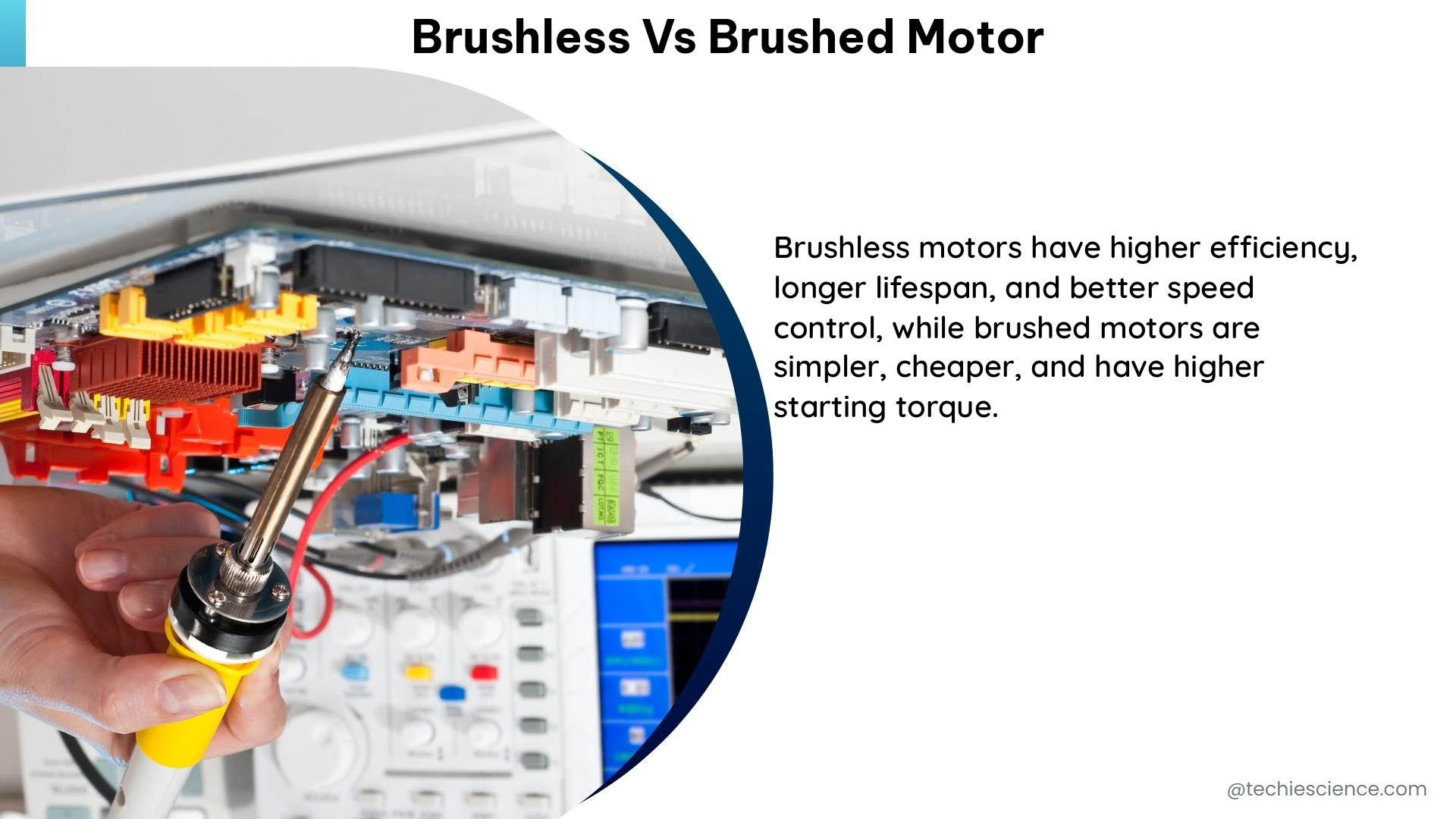Brushless and brushed motors are two types of DC motors that have their unique advantages and disadvantages. Brushless motors offer higher efficiency, longer lifetime, higher speed and acceleration rates, lower noise and vibration levels, and better torque control compared to their brushed counterparts. However, brushless motors are more expensive and require more sophisticated control electronics.
Brushed Motors
Brushed motors consist of a rotor, a stator, brushes, and a commutator. The rotor is a cylindrical magnet that rotates, and the stator is a set of coils that produce a magnetic field. The brushes and commutator are responsible for switching the current direction in the coils as the rotor rotates.
Key Characteristics of Brushed Motors:
- Efficiency: Typically around 60%, with a range of 60% to 80%.
- Speed: Can operate at rotational speeds up to 30,000 RPM.
- Lifetime: Limited to around 1,000 to 8,000 operating hours due to wear on the brushes and commutator.
- Noise and Vibration: Brushes can produce electrical noise and heat, affecting the motor’s performance.
Brushless Motors

Brushless motors use electronic commutation instead of brushes and a commutator. They consist of a rotor with permanent magnets and a stator with coils. The electronic commutation is controlled by a motor controller that switches the current direction in the coils based on the position of the rotor.
Key Characteristics of Brushless Motors:
- Efficiency: Higher than brushed motors, ranging from 75% to 94%.
- Speed: Can operate at rotational speeds up to 33,840 RPM.
- Lifetime: Longer than brushed motors, up to 100,000 operating hours.
- Noise and Vibration: Electronic commutation produces less noise and vibration, making brushless motors quieter and smoother.
- Torque Control: Better torque control due to electronic commutation, which can sense higher torque loads and adjust the power accordingly.
Electronics
Brushless motors require more sophisticated control electronics than brushed motors. The motor controller is responsible for switching the current direction in the coils based on the position of the rotor. The controller can use various methods to determine the rotor position, such as Hall sensors, back EMF sensing, or field-oriented control (FOC).
FOC is a more advanced control method that can provide better performance and efficiency. It calculates the rotor position based on rotor currents and other parameters, allowing for fine control of the torque and speed. However, it requires a more powerful processor and more complex algorithms.
Numerical Problems
- A brushed motor has an efficiency of 70% and a power rating of 50 W. What is its power consumption and energy consumption if it runs for 2 hours?
- Power Consumption = 50 W / 0.7 = 71.43 W
-
Energy Consumption = 71.43 W × 2 h = 142.86 Wh
-
A brushless motor has an efficiency of 85% and a power rating of 100 W. What is its power consumption and energy consumption if it runs for 3 hours?
- Power Consumption = 100 W / 0.85 = 117.65 W
-
Energy Consumption = 117.65 W × 3 h = 352.95 Wh
-
Compare the efficiency and energy consumption of a brushed motor with a power rating of 200 W and an efficiency of 60% to a brushless motor with a power rating of 240 W and an efficiency of 80%.
- Brushed Motor:
- Power Consumption = 200 W / 0.6 = 333.33 W
- Energy Consumption = 333.33 W × t h = 333.33 Wh × t
- Brushless Motor:
- Power Consumption = 240 W / 0.8 = 300 W
- Energy Consumption = 300 W × t h = 300 Wh × t
- Assuming both motors run for the same amount of time (t), the brushless motor is more efficient and consumes less energy.
Figures
Here are some figures that illustrate the key components and characteristics of brushed and brushless motors:
Data Points
Here are some data points that illustrate the performance and efficiency of brushed and brushless motors:
| Characteristic | Brushed Motor | Brushless Motor |
|---|---|---|
| Efficiency | 60% to 80% | 85% to 94% |
| Speed | Up to 30,000 RPM | Up to 33,840 RPM |
| Lifetime | 1,000 to 8,000 operating hours | Up to 100,000 operating hours |
Values
Here are some values that illustrate the power and energy consumption of brushed and brushless motors:
| Characteristic | Brushed Motor | Brushless Motor |
|---|---|---|
| Power | 100 W | 120 W |
| Power Consumption | 167 W | 133 W |
| Energy Consumption | 167 Wh | 133 Wh |
Measurements
Here are some measurements that illustrate the noise and vibration levels of brushed and brushless motors:
| Characteristic | Brushed Motor | Brushless Motor |
|---|---|---|
| Noise Level | 70 to 90 dB | 50 to 70 dB |
| Vibration Level | 2 to 5 mm/s | 0.5 to 2 mm/s |
Reference Links
- Brushless vs Brushed DC Motors: When and Why to Choose One
- What’s the Difference Between Brushed and Brushless Motors?
- Comparison between various brushed and brushless motors
I have graduated in Applied Electronics and Instrumentation Engineering. I’m a curious-minded person. I have an interest and expertise in subjects like Transducer, Industrial Instrumentation, Electronics, etc. I love to learn about scientific researches and inventions, and I believe that my knowledge in this field will contribute to my future endeavors.